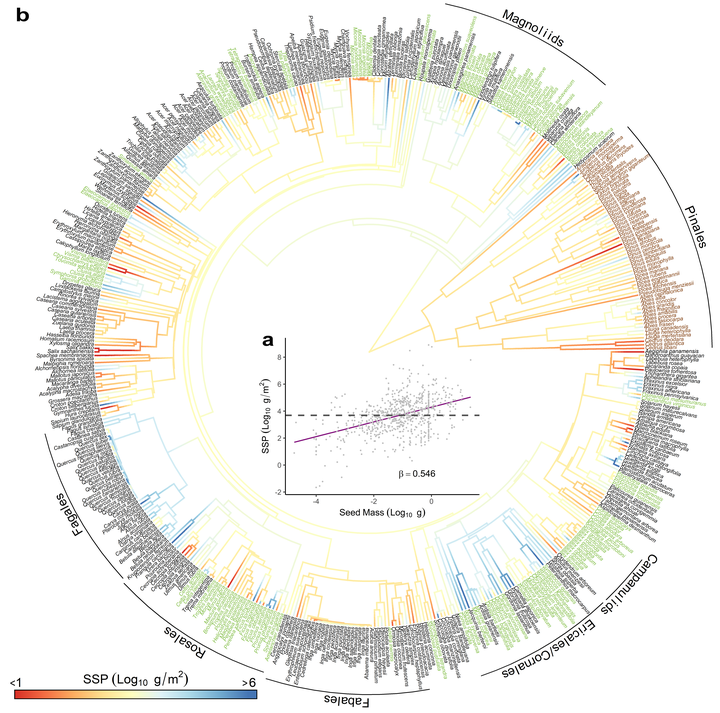Limits to reproduction and seed size-number trade-offs that shape forest dominance and future recovery
 a Species seed production (SSP, g seed per m2 tree basal area) is not constrained by the strict size-number trade-off (dashed line with a slope of zero). Instead, it varies over ten orders of magnitude and has a positive correlation with seed mass across 714 tree species. b SSP exhibits phylogenetic coherence for 482 species having phylogeny data (68% of species). Brown and green text highlight species that produce coniferous cones and fleshy fruits, respectively.
a Species seed production (SSP, g seed per m2 tree basal area) is not constrained by the strict size-number trade-off (dashed line with a slope of zero). Instead, it varies over ten orders of magnitude and has a positive correlation with seed mass across 714 tree species. b SSP exhibits phylogenetic coherence for 482 species having phylogeny data (68% of species). Brown and green text highlight species that produce coniferous cones and fleshy fruits, respectively.
Abstract
The relationships that control seed production in trees are fundamental to understanding the evolution of forest species and their capacity to recover from increasing losses to drought, fire, and harvest. A synthesis of fecundity data from 714 species worldwide allowed us to examine hypotheses that are central to quantifying reproduction, a foundation for assessing fitness in forest trees. Four major findings emerged. First, seed production is not constrained by a strict trade-off between seed size and numbers. Instead, seed numbers vary over ten orders of magnitude, with species that invest in large seeds producing more seeds than expected from the 1:1 trade-off. Second, gymnosperms have lower seed production than angiosperms, potentially due to their extra investments in protective woody cones. Third, nutrient-demanding species, indicated by high foliar phosphorus concentrations, have low seed production. Finally, sensitivity of individual species to soil fertility varies widely, limiting the response of community seed production to fertility gradients. In combination, these findings can inform models of forest response that need to incorporate reproductive potential.
Broader impacts
- Seed production is the foundation of tree fitness and measures the regeneration potential of forest that are increasingly lost to global forest dieback
- The finding provides the first global patterns in tree seed production and quanties its response to soil feritlity and foliar nutrient gradient
- The fact that angiosperms are more productive than gymnosperms can potentially address the angiosperm radiation in the Cretaceous (i.e., Darwin’s
Abominable mystery)
Research highlights
- Seed production is not constrained by a strict trade-off between seed size and numbers. Instead, seed numbers vary over ten orders of magnitude, with species that invest in large seeds producing more seeds than expected from the 1:1 trade-off.
- Gymnosperms have lower seed production than angiosperms, potentially due to their extra investments in protective woody cones.
- Nutrient-demanding species, indicated by high foliar phosphorus concentrations, have low seed production.
- Sensitivity of individual species to soil fertility varies widely, limiting the response of community seed production to fertility gradients.